Tessa Cheek
The Dry Sea
ISSUE 34 | BAIT AND SWITCH | NOV 2013


In her wanderings we hear from time to time an undertone of the deepest sorrow, but never the agonized cry of fear or horror which makes madness dreadful or shocking. And the picture of her death, if our eyes grow dim in watching it, is still purely beautiful.
Bradley describes Ophelia
Shakespearean TragedyÉduardo Levé describes himself
I prefer a ruin to a monument.
Autoportrait
By the time you see the hollow walls, you’ve been driving for five hours on assignment through southern Colorado. The ruin flashes by on the north side of US 50, a mile outside Rocky Ford.
Shards of yellow brick. The glassless iron frames of Mediterranean arched windows 30 feet high along the building’s southern face. Trees grow up all around and inside. The light shines through it. Chainlink surrounds it. You know you have to turn around.
You would have wanted to stop, no matter what. In this part of the country the land is flat and unless coated in an electric, irrigated green, the earth is the color of ash. Here a stand of trees around a shattered castle could only be a dream.
You are just 23 but know that most dreams do not bear up under pressure. You have learned not to touch, not to look too closely, and instead to remember that baited hook with fondness—that flash of something beautiful and strange at the side of the highway you are riding, always 11 miles over the speed limit, to some urgent if uncertain destination.
But this time you are on assignment. You have an editor who has told you to take pictures of broken, shutdown things.
Your editor gives you an example. She’s just photographed the old Colorado University Medical School. Now abandoned and overgrown, it’s been tagged by a gang that calls itself “CIVILIZED.”
The story’s to do with the shutdown of the federal government. A kind of “making real,” or “bringing home,” that goes beyond pictures of closed national parks into an entirely independent species of shutdown. In the end it turns out the two are better linked by the vocabulary of poetry than of journalism.
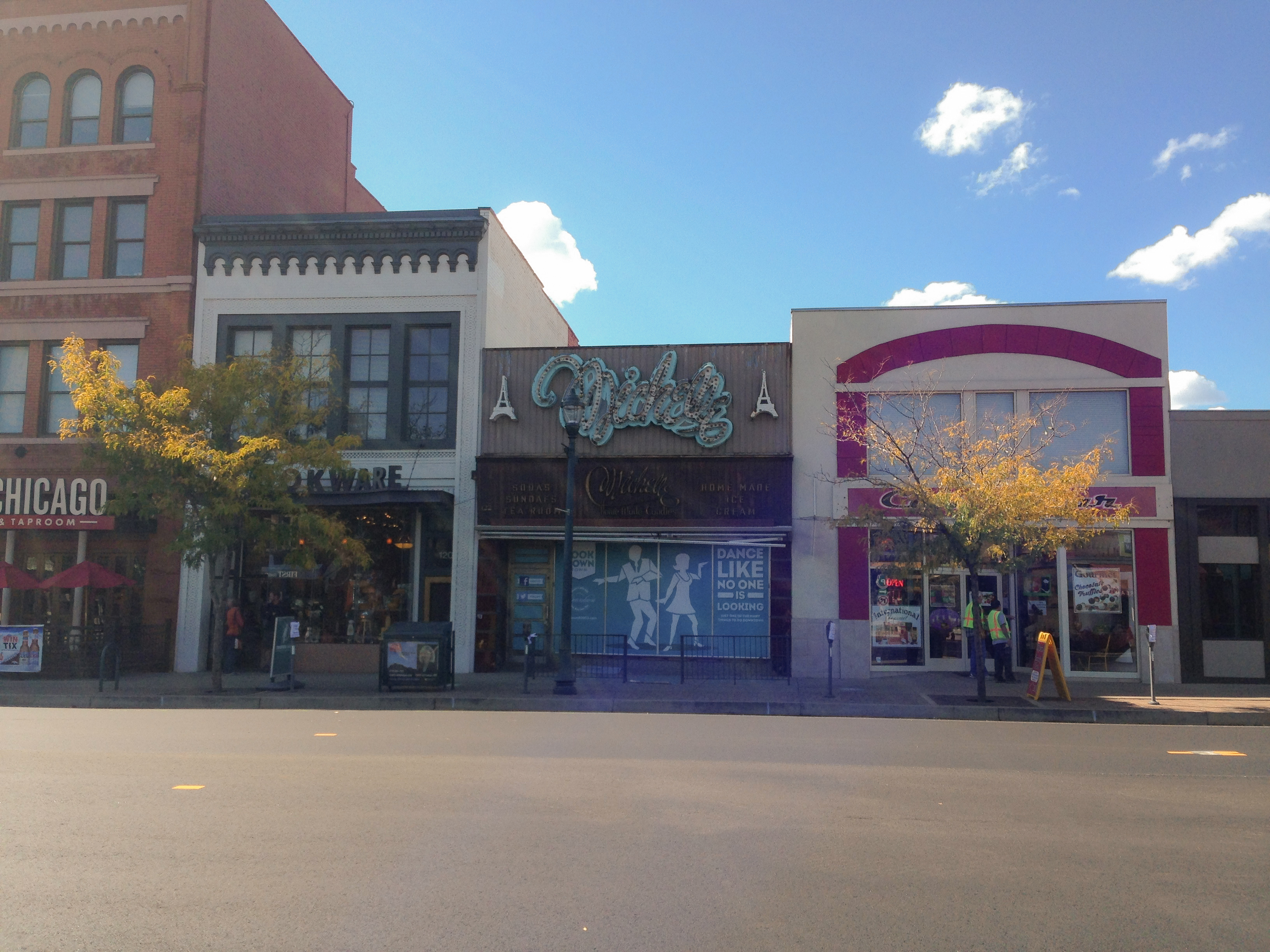
First you think of Colorado Springs, where you grew up, and where the storefront of an ice cream parlor you used to visit with your father still stands empty. Michelle’s. You used to sit across from him in a vinyl booth. The walls were covered in murals featuring girls in petticoats. The sundaes came in tall glasses with long spoons. You always got mint-chocolate chip. No nuts. The hot fudge always pooled at the bottom. They got shut down, for tax evasion you heard, six years ago. You remember the sign on the door the day it closed. You were skipping class with high school friends to buy Jordan Almonds. They were like beautiful, pastel river stones.
The building kept failing to sell at auction. The city covered the dusty windows in a bizarre imperative: DANCE LIKE NO ONE IS LOOKING. Right next door a brand-new candy shop opened up. You take the picture on your way south and say out loud, ridiculous. Back on the highway, heading for Pueblo with the windows all down, you realize you are angry in a heady, free-floating way. The radio is up very loud but all you hear is wind. You are not angry at the tax collectors or evaders, not at the ambitious new candy makers, not even at your own father. It’s just that you leave these things to resolve themselves only to find that they deteriorate further, endlessly inscrutable.
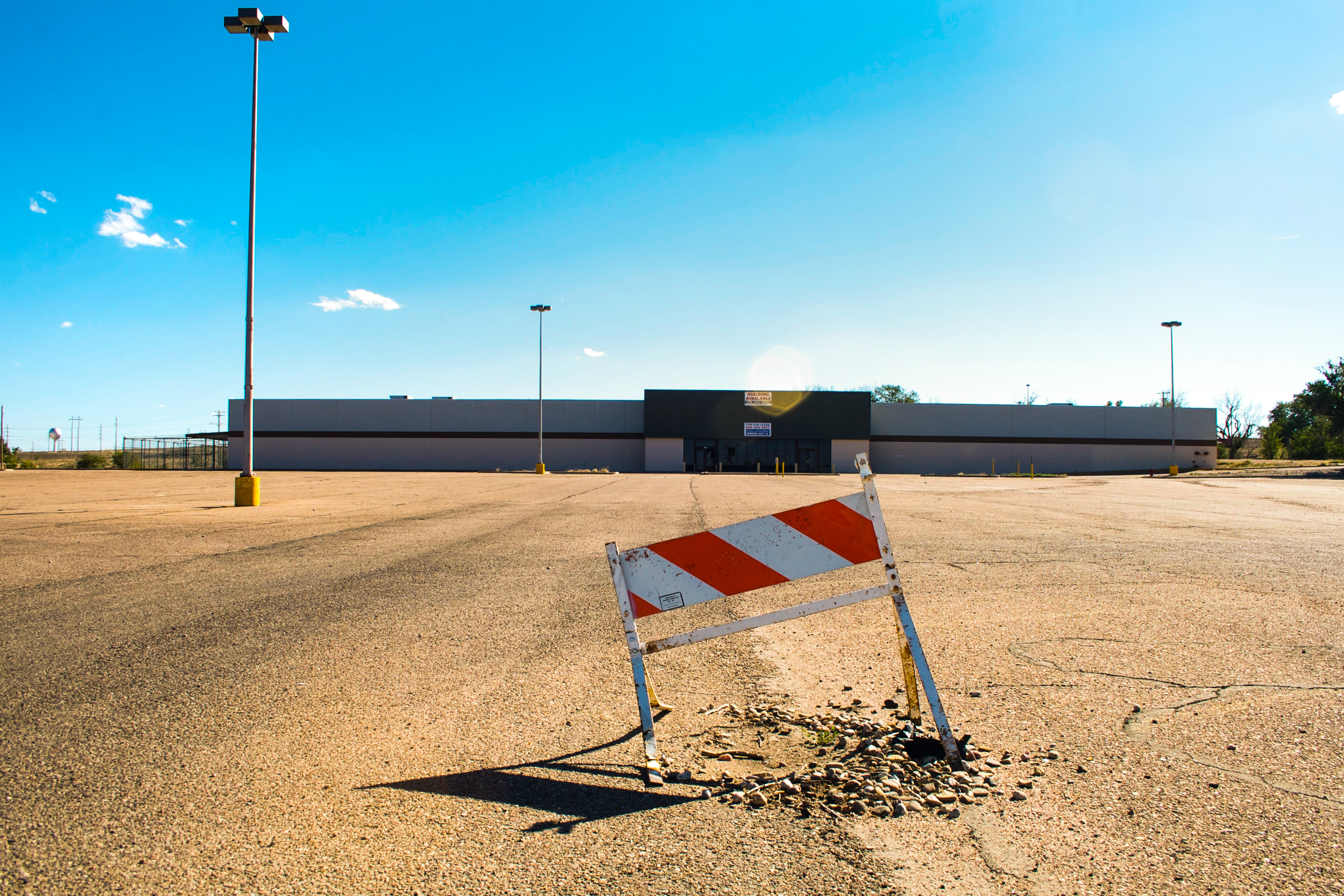
In La Junta you take a picture of a shutdown Walmart. A woman in the neighboring thrift shop tells you Corporate abandoned the building when they opened a new Super Walmart just outside of town.
“I can’t for the life of me understand why they didn’t just add on,” she says, while you buy her conversation in the form of an extremely ordinary glass vase for 1 dollar plus 7 cents in sales tax.
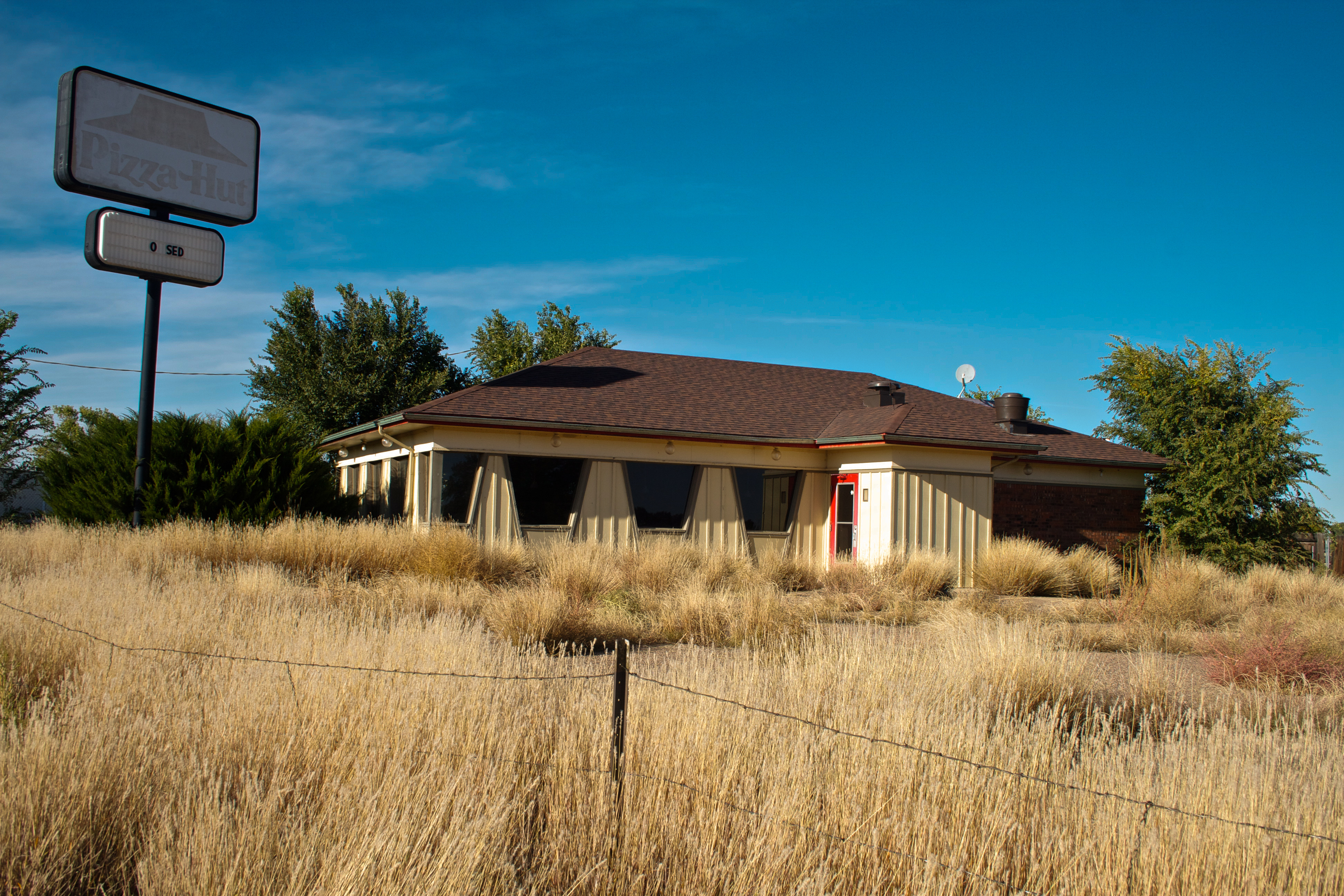
Not long after, you pull over for an “O SED” Pizza Hut in a sea of tall grasses. Here the highway splits to wrap around Rocky Ford, where population has declined by 10% in as many years, where a cantaloupe-borne listeria outbreak which killed 33 people is said to have originated in 2011.
Eventually the outbreak was traced to a town 95 miles eastward where they also grow cantaloupes and also put the prized Rocky Ford sticker on the rinds. In never legally turning their home into a brand, the true meloneers of Rocky Ford had made a terrible, if unforeseeable, mistake. For a gut-wrenching season they seemed indelibly sullied. They harvested 20 percent of their usual haul and sold it only in Colorado. They begged for a forgiveness that made dollars but little sense.
The listeria story makes you feel tired. You’re carrying a full belly of carnitas in your stomach, a gift pumpkin from a cantaloupe farmer in your trunk, and a plan to drive over the Continental Divide before nightfall in your head.
And that’s when you pass it. The ruin goes by in a flash of unexpected trees, brick, rare arched forms. After 200 yards you make the U-turn. You say to yourself something which a blonde and buoyant yoga teacher said to you earlier in the week, milliseconds before you ditched out on chair pose: This is how you change.
Turn back and touch the dream. Park the car on a gravel road. Marvel at the falling walls. Someone has planted flowers all around—pansies, roses, columbine, bleeding hearts. You see a yellow hose winding through them without understanding what it means.
On the highway side you reach your camera high over the chainlink and shoot blind. Behind you the cars roar. You know you’re obsessed because their flickering presence doesn’t make you self-conscious.
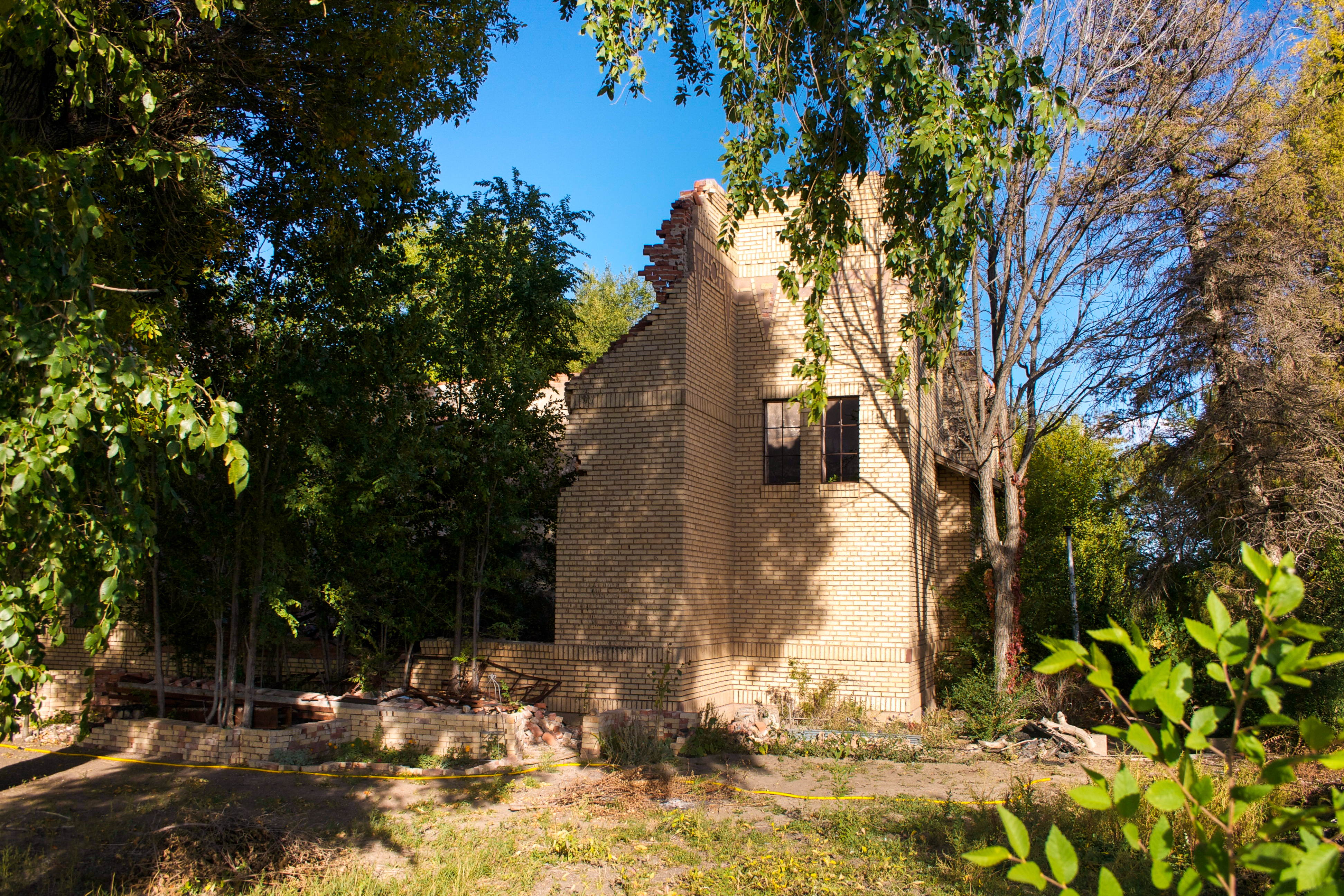
You stomp all around the place. Camera braced to brow bone. Talking to yourself, saying beautiful and strange and beautiful. All kinds of oddities: a rusty, excised exercise bike. Single shoes. Metal shelves with Dewey decimal numbers. It occurs to you that there must have been a fire.
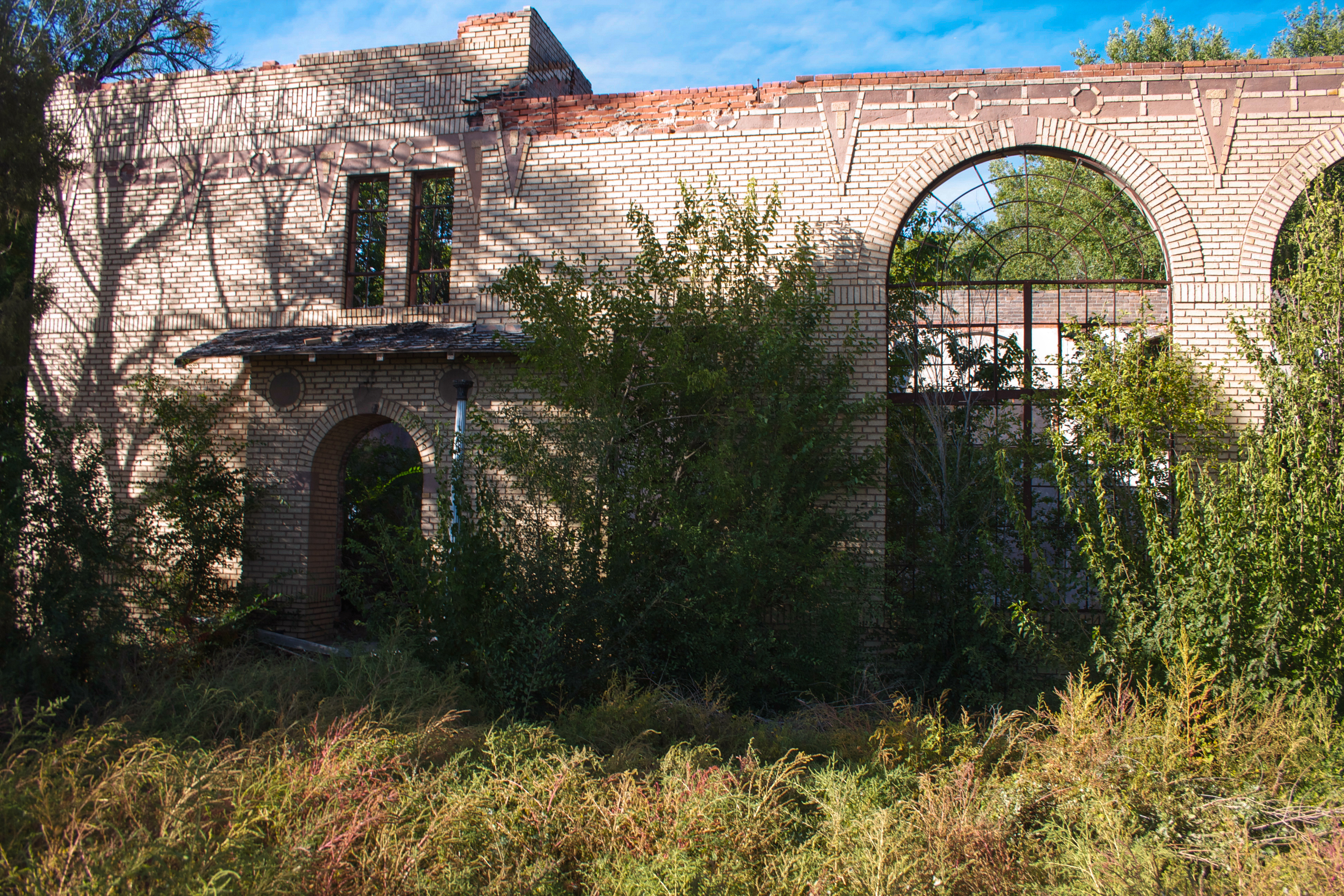
It is not after this picture of the fallen panda that you begin to feel uncomfortable. It is not after traipsing further back, lens like a hound’s snout. Not after shooting through a blown-out window again and again, trying to capture some balance of luminous yellows in the leaves of the trees together with the umber of something large and rusted hulking in the undergrowth. It is when you see that the fire was hot enough to weld silverware to the top of a metal cabinet.
On cue: the sound of a small dog’s bark. How obvious now, those piles of things leading all the way to a trailer in the shadows. This is a domestic graveyard. Time to go.
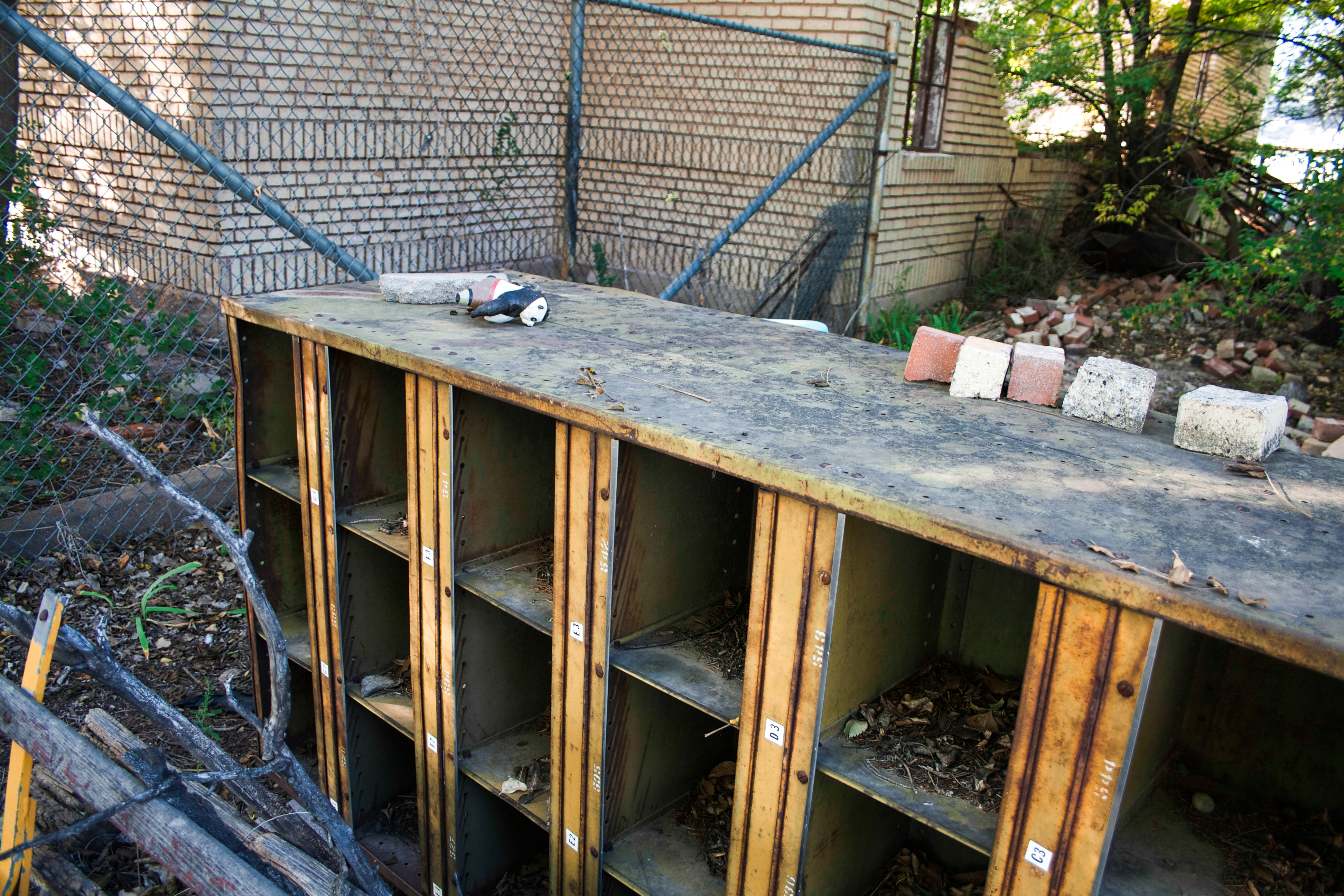
Time to pick your way out front again into the afternoon’s long, hot light. Back to the chain link and a big sign that says CLOSED. You’re about to photograph that when, suddenly, there she is, smiling politely, standing in her scrubs in the waist-high grass. It’s like a dream in which you see someone you know to be another person’s grandmother and yet simultaneously believe her to be yours.
“What did this used to be?” you call in your most innocent, girlish voice. “It’s like a secret garden!”
Mine! she seems to say. You cannot hear each other over the scream of the highway. The two of you reconnoiter at the property’s flank, by your car, by the gravel road, where your exit is assured and things are quieter.
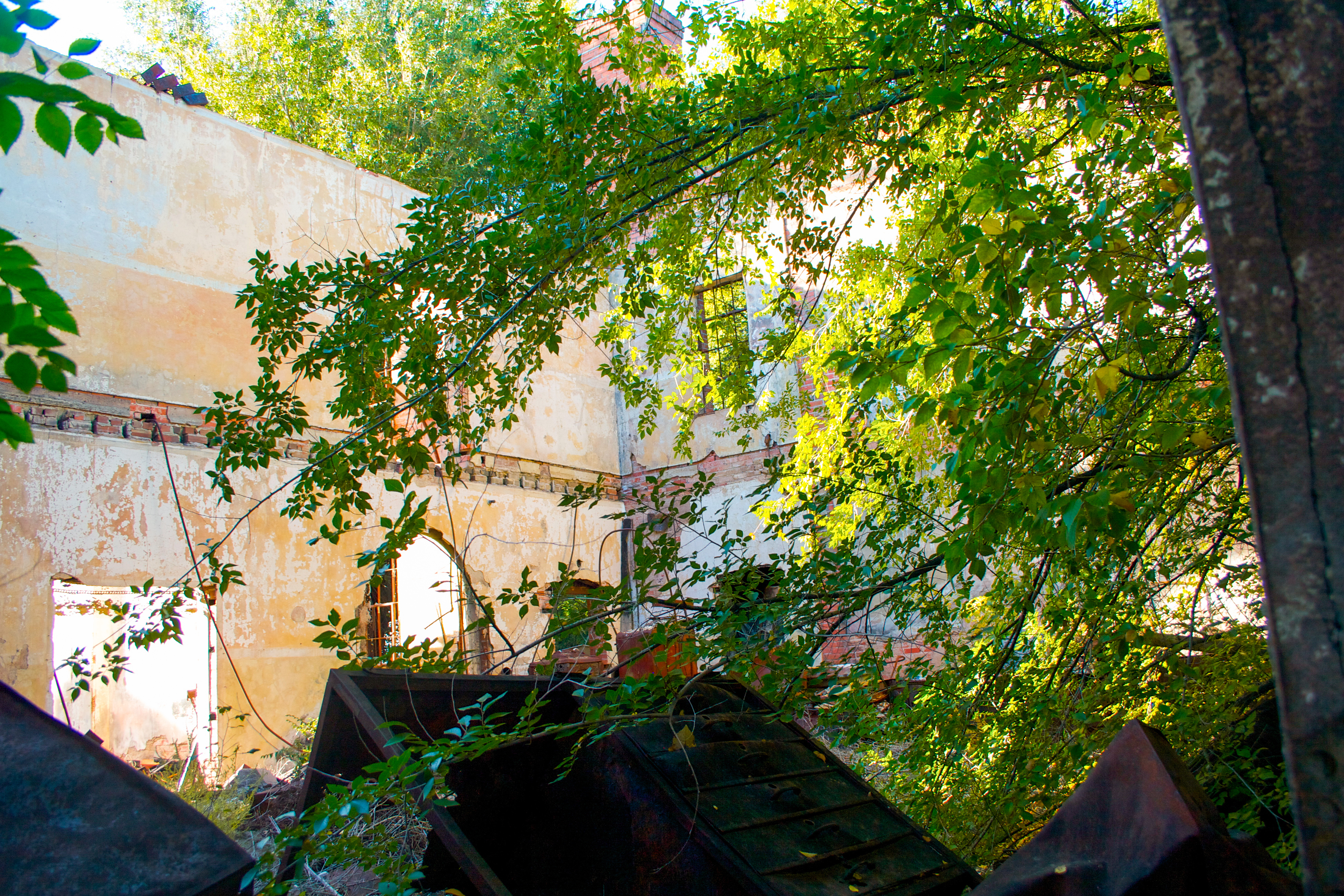
This is how you meet her, Lady O. Across a low wire fence. You share a particular nervous habit: ripping at whatever plant material is close at hand. In this case it is the wild grass that grows in the west like miniature wheat. It’s long with tufts of bunched seeds and you can pull them apart, one from one. Very satisfying.
Lady O is even more grandmotherly up close. She has the short grey hair that curls—frayed, downy wire. She has Velcro-buckled shoes. She has small, round hands that never stop moving. You want to take her picture but you don’t.
The pair of you tear apart the wild plants, each on your own side of the fence, while Lady O tells about the ghost town of Vroman (population ~5) which once watered the steam trains running the tracks across the highway. And once there was a school here, this one, behind her, an exemplary Mediterranean Revival designed by the firm Mountjoy, French & Frewen. Built in 1918.
The whole family O moved into the elementary school in 1973, two years after the handful of students still in attendance were moved to Rocky Ford. Dame O was an antiques dealer and for twenty-five years the school auditorium served as a kind of shop. The family slept in the wrap-around balcony above it, partitioning the cantilever into four bedrooms with various historic armoires.
“When we went to sleep it was like an old sitcom, all of us saying goodnight across the dark,” remembers Lady O.
In 1987, Colorado built its second major prison, the Arkansas Valley Correctional Facility for 1,000 men, a few miles north.
“When it first opened they used to leave those big old floodlights on all the time,” says Lady O. “The night was like the day and our whole town complained.”
The few of them got the lights dimmed, but not before two women guards had their throats slit.
“I tell you, one of them survived. She turned her head just in time. But she can’t speak,” Lady O tucks her chin defensively and mimes the cut. “Right through the vocal cords.”
Lady O used to be a prison guard herself at the even larger, privately owned facility to the west.
“They used to call me grandma over there. Ha. I’m nobody’s grandma.”
She doesn’t tell you when she retired but later you look up the prison and find that a riot there in 2004 injured hundreds and ended in a class-action lawsuit which the prisoners won. A batch of new inmates destroyed several parts of the prison because they’d been moved from Washington State and didn’t want to be so far from their families. “Animals are probably treated better,” an inmate told the local paper.
A year later, Lady O’s house burned down. The fire took all her cats. It took all the antiques. It took the roof, which Lady O had just finished tarring and which had, at last, stopped leaking. It took everything except Lady O herself and her little dog. Nothing was insured.
“You know, I don’t know how it started,” she says. “I know where, firemen from three towns came just as it got really bad and they saw. It started in the auditorium.”
Lady O was in town buying a coat. She saw the dark smoke rise over the horizon and she knew. She points to where the tar melted, fell and stuck like permanent rain down the side of the schoolhouse.
“When I left, the sheets were still white in the windows. So I know they hadn’t caught yet.” She shakes her head, changes the subject.
“Did you know, there was a time, decades ago, when Rocky Ford cantaloupe sold for 12 U.S. dollars a slice in Japan?”
“You need hot days and cold nights,” she adds. “You need to give them water until they’re almost ripe, and then take it away. That brings out the sugar. That’s why they’re the sweetest melons in the world.”
The wind comes in, cutting across everything, rustling miles of dry stalks. Lady O says you’d better get going if you plan to cross the mountains tonight. You leave her standing by the fence. The drive is numinous all the way through Pueblo.
Before peeling west off the plains you pass a stand of windmills that suck the night towards them out of the valleys. You realize you never saw the small dog or asked what became of the rest of her family. In your memory of her you name her Lady O. A solitary figure on a dry sea.
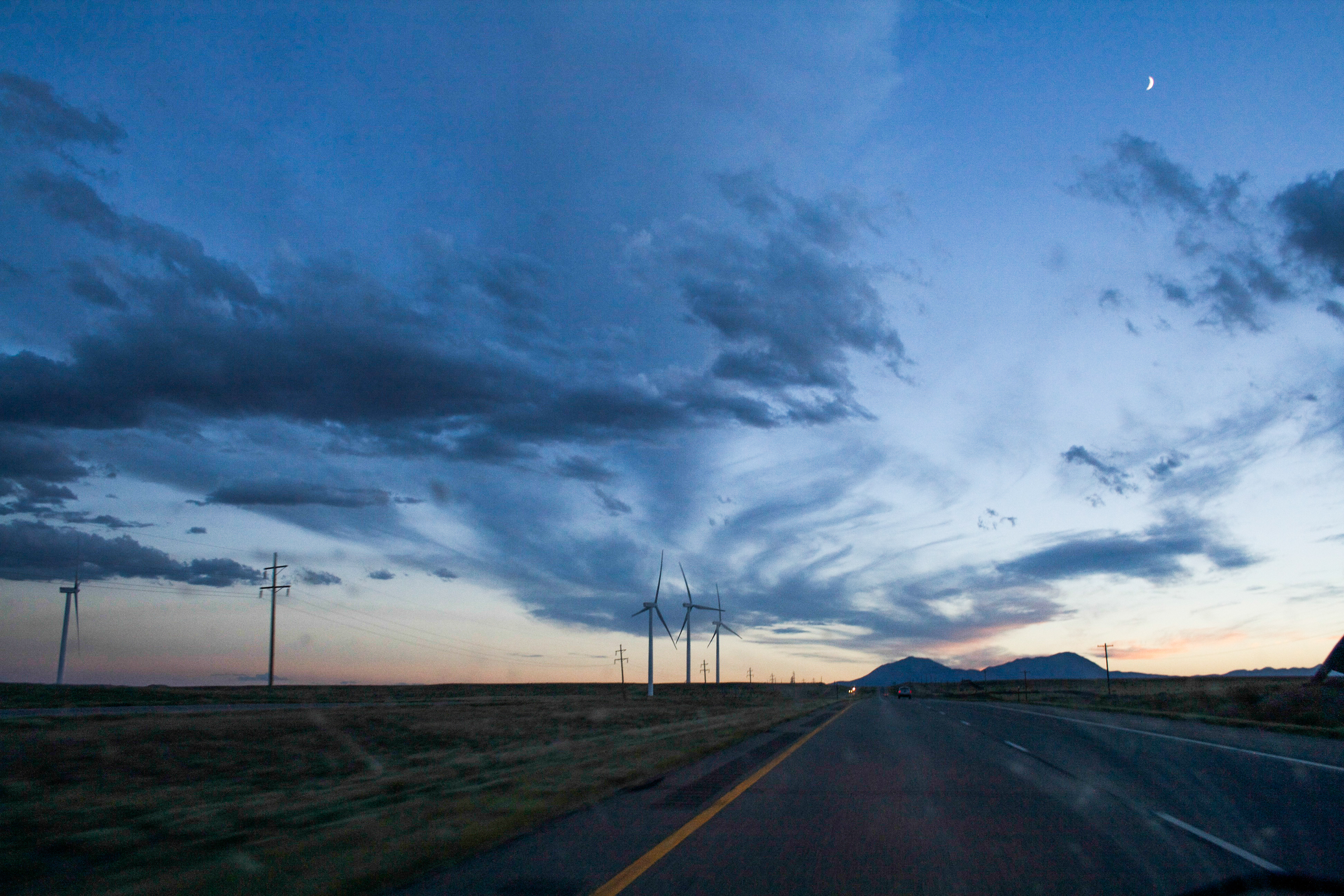
Then the climb, mesa to mesa, a giant set of stairs up into the Rockies. You buy a hotdog in a Walsenburg 7-11. A man wearing a cowboy hat lets you have the front of the weary line. You ask him how much further to Wolf Creek Pass. He says, “More than 100 miles.”
You cede the line and go back to the humming coolers for a 6-pack of vintage label Coors. You check into the motel next door, right off the highway. It’s clean but the carpet smells so sad you chain the door and prop it open. You drink your beer grimacing into your laptop which sits on a built-in desk with a big mirror behind. It feels like Skyping with yourself. You get drunk and avoid your own eyes.
Who is Lady O, who smiled when she drew her finger across her throat, thinking of a knife? Lady O, who lives behind a ruin and waters the flowers around its foundation.
You ask yourself to believe that she is happy. Why shouldn’t she be? She is the one who gets to see the burnt-out school catch early morning mist in its halls, see it fill up with snow and white-light in January. And the trees—every season they are taller. She owns the poetry of a great, terrible loss instantiated in architecture. She lives inside an uncanny, lucid American dream.
You do not want to believe she is happy, you must believe it.
You go outside with your camera.
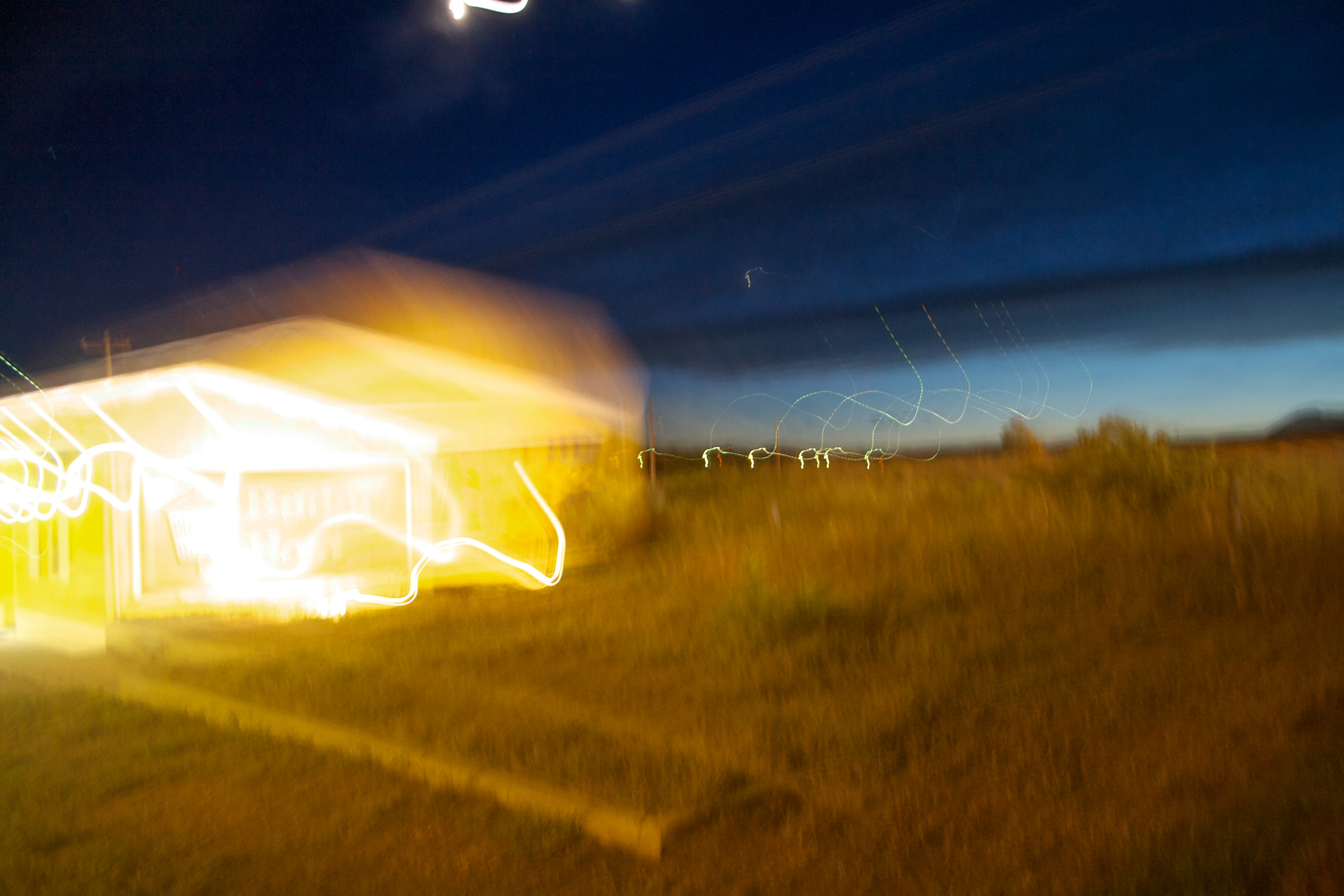
In this picture of the Budget Host motel, the night looks like a lid forever closing or opening. Here is the Budget Host exploding through a long, unsteady shot, through looping versions of itself, through time. Here is the Budget Host, glowing, impermanent domicile for anyone with $48.50. The Budget Host—yes, it is glorious! 
The Hypocrite Reader is free, but we publish some of the most fascinating writing on the internet. Our editors are volunteers and, until recently, so were our writers. During the 2020 coronavirus pandemic, we decided we needed to find a way to pay contributors for their work.
Help us pay writers (and our server bills) so we can keep this stuff coming. At that link, you can become a recurring backer on Patreon, where we offer thrilling rewards to our supporters. If you can't swing a monthly donation, you can also make a 1-time donation through our Ko-fi; even a few dollars helps!
The Hypocrite Reader operates without any kind of institutional support, and for the foreseeable future we plan to keep it that way. Your contributions are the only way we are able to keep doing what we do!
And if you'd like to read more of our useful, unexpected content, you can join our mailing list so that you'll hear from us when we publish.
